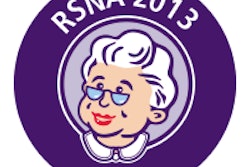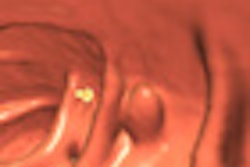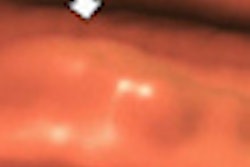The use of noncathartic bowel preparation before CT colonography (CTC) delivers good sensitivity for clinically significant polyps, and may also increase colorectal cancer screening compliance, according to a report in the American Journal of Roentgenology.
In a study of asymptomatic subjects at average risk for colorectal cancer and polyps, noncathartic CTC combined with electronic cleansing showed 76% sensitivity for the detection of polyps 6 mm and larger and similar sensitivity for polyps 10 mm and larger, finding the lone cancer in the study cohort (AJR, October 2013, Vol. 201:4, pp. 787-794).
Including oral iodine contrast material improves the specificity of the exam, and the use of electronic cleansing was thought to improve polyp conspicuity.
"Although our study does not directly address who would benefit from noncathartic CTC, others have suggested that it may be an important option for polyp detection in higher-risk patients who are frail or in those unwilling to undergo an alternative full structural evaluation of the colorectum," wrote Dr. Joel Fletcher, Dr. Alvin Silva, Dr. C. Daniel Johnson, and colleagues from the Mayo Clinic in Rochester, MN; Scottsdale, AZ; and Jacksonville, FL.
Colorectal cancer screening dramatically boosts the cure rate for colorectal cancer, but about 40% of those in the U.S. older than 50 still do not undergo screening. Several studies have shown that the use of laxatives for bowel cleaning before both conventional colonoscopy and CTC weighs negatively on patients' minds and is a major disincentive for screening.
The current study aimed to evaluate the image quality and performance of noncathartic CTC using four similar bowel-tagging regimens and standard noncathartic CTC visualization techniques in an asymptomatic cohort.
The study team prospectively examined 564 asymptomatic subjects who underwent noncathartic CTC without dietary modifications. The prep included 21 g of barium as a tagging agent, either with or without iodinated oral contrast material in four regimens. Conventional optical colonoscopy performed within 30 days of CTC served as the reference standard.
A gastrointestinal radiologist evaluated examinations using primary 2D search supplemented by electronic cleansing and 3D problem-solving. Results, including prep and image quality as well as sensitivity and specificity, were compared with complete colonoscopy findings after bowel purgation and with retrospective unblinded evaluation in 556 of the patients.
In all, 7% of the subjects had polyps 6 mm or larger and 3% had polyps 10 mm and larger. Adding iodine to the prep significantly improved the percentage of tagged stool (p ≤ 0.0002) and specificity (80% versus 89%-93%, respectively; p = 0.046). Sensitivity was 69% for the 20 lesions that were 10 mm and larger.
The overall sensitivity of noncathartic CTC for adenomatous polyps 6 mm and larger was 76%, similar to the 74% sensitivity of the iodinated regimens with most patients.
The authors considered the study's major limitation to be the variation in the amount of tagging material administered, but an analysis showed no difference in performance between the techniques, the group explained.
Compared with conventional colonoscopy, the negative predictive value of virtual colonoscopy without a cathartic prep was 98%. All eight tubulovillous adenomas were detected, and the single cancer in the cohort was also detected at CTC, the group reported.
Finally, electronic cleansing was thought to improve conspicuity of 10 of 21 visible polyps 10 mm and larger. "In only two patients (10%), there was significant erosion of the edges of the polyp that degraded polyp conspicuity," the group wrote.
"Noncathartic CTC likely has a potential role in colorectal cancer detection," they concluded. This study and a previous article by Zalis et al showed that the "upper limit of performance for noncathartic CTC is similar to that of CTC performed with bowel purgation."



















